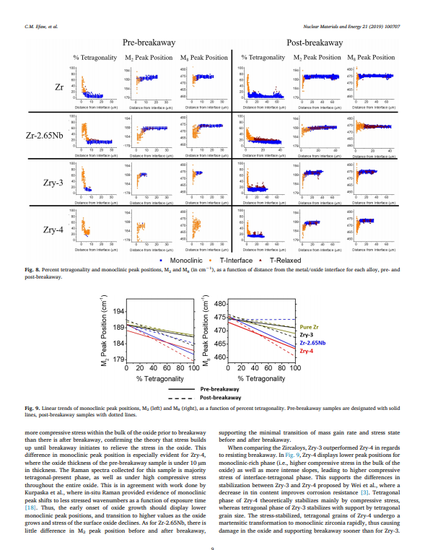
Raman mapping of sectioned zirconium cladding oxides was performed to analyze different spectral features before and after breakaway, as well as between zirconium and its alloys Zr-2.65Nb, Zry-3, and Zry-4. Oxide phase composition, or percent tetragonality, was defined to compare tetragonal to monoclinic zirconia. Percent tetragonality was spatially mapped to support distinction of zirconia phase distribution. A tetragonal-rich layer was seen at the metal/oxide interface, while post-breakaway samples exhibited increased amount of tetragonal phase in the bulk of their oxides. Spatial mapping of spectral peak location and half-width at half-maximum was accomplished to distinguish differences in stability mechanisms of tetragonal-rich zirconia phase. Shifts in monoclinic peak positions provided mapping of relative stress state, supporting the differences in stabilization of tetragonal phase near the metal/oxide interface and tetragonal phase in the bulk of the oxide. Tetragonal phase near the metal/oxide interface is stabilized through support of oxygen sub-stoichiometry and compressive stress. Tetragonal phase observed in the bulk of the oxide is stabilized through oxygen sub-stoichiometry, void of compressive stress. A linear trend between percent tetragonality and stress state was determined. This resulted in a connection between mechanism of tetragonal to monoclinic phase transformation and a cladding's ability to resist oxidation and breakaway. Poor performing samples displayed greater stress gradients, driven by lattice mismatch at the metal/oxide interface, as well as between tetragonal and monoclinic phase boundaries. Tetragonal phase at the metal/oxide interface for superior performing samples have reduced epitaxial growth of tetragonal grains, lowering compressive stress gradients and provided more resistant inner-oxide layers. With increased utility of Raman spectroscopy for characterizing zirconium cladding materials, different degradation mechanisms can be further understood.

For a complete list of authors, please see article.